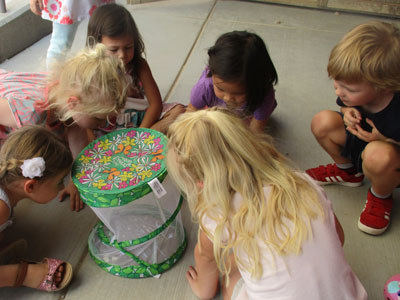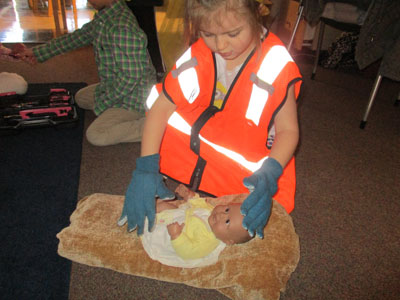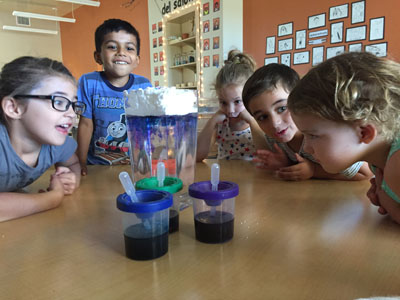


We believe that children learn best:
- by exploring concepts through hands-on activities.
- through long blocks of uninterrupted play.
- with opportunities to explore both outdoors and indoors.
- when they have a caring, respectful relationship with peers and adults.
- in an atmosphere that celebrates the joys of everyday life.
- when exposed to activities and experiences that are culturally relevant in their daily lives.
Emergent Curriculum
Emergent curriculum describes the kind of curriculum that develops when exploring what is "socially relevant, intellectually engaging, and personally meaningful to children." The basic idea is that organic, whole learning evolves from the interaction of the classroom participants, both children and adults. "As caring adults, we make choices for children that reflect our values; at the same time we need to keep our plans open-ended and responsive to children" (Jones and Nimmo, 1994, p3).
In emergent curriculum, both adults and children have initiative and make decisions. This power to impact curriculum decisions and directions means that sometimes curriculum is also negotiated, between what interests children and what adults know is necessary for children’s education and development. Ideas for curriculum emerge from responding to the interests, questions, and concerns generated within a particular environment, by a particular group of people, at a particular time (Cassady, 1993).
Emergent curriculum is never built on children’s interests alone; teachers and parents also have interests worth bringing into the curriculum. The values and concerns of all the adults involved help the classroom culture evolve. The curriculum is called emergent because it evolves, diverging along new paths as choices and connections are made, and it is always open to new possibilities that were not thought of during the initial planning process (Jones and Reynolds, 1992).
Emergent curriculum arises naturally from adult-child interactions and situations that allow for "teachable moments.” It connects learning with experience and prior learning. It includes all interests of children and responds to their interests rather than focusing on a narrow, individual, or calendar driven topic. It is process rather than product driven. The curriculum is typically implemented after an idea or interest area emerges.
An emergent curriculum is one that builds upon the interests, experiences, and cultures of the children in a particular group. It is often spontaneous and responsive to the immediate interests of a group of children. Topics are driven by the ideas, excitement, information and questions from the children themselves.
Ideas can be supported and extended by providing equipment, books, craft supplies, and experiences through which the children can learn more about their natural interests and curiosities. The teacher is not the “expert” who knows all and teaches the children but rather she co-explores alongside the children and observes and encourages their discoveries.
The initial topic may sprout off in many directions combining several seemingly unrelated topics. Each topic may last a day, a week, a month or more – as long as the children are interested in pursuing the ideas. The teacher can develop a plan by observing and listening to the children at play or by asking the children open-ended questions.
Key Principles of Emergent Curriculum
Our understanding of children guides our decision-making. We view children as competent; full of wonder; willing to investigate, critique, reflect, and collaborate. This understanding shapes our decisions about how to arrange our classroom environment, schedule our days, and plan our curriculum.
Teachers pay careful attention to the use of space and time. The classroom environment sets the tone, inviting children to explore, collaborate, reflect, and communicate using a range of media. The schedule each day allows for long stretches of open-ended time during which children can pursue their questions, passions, and developmental themes.
Curriculum planning is based on observation. Teachers observe children as they play, paying close attention to recurring themes, developmental issues, and underlying questions. Observations guide curriculum planning, as we create opportunities for children to deepen their thinking, represent their understandings, and encounter new perspectives.

